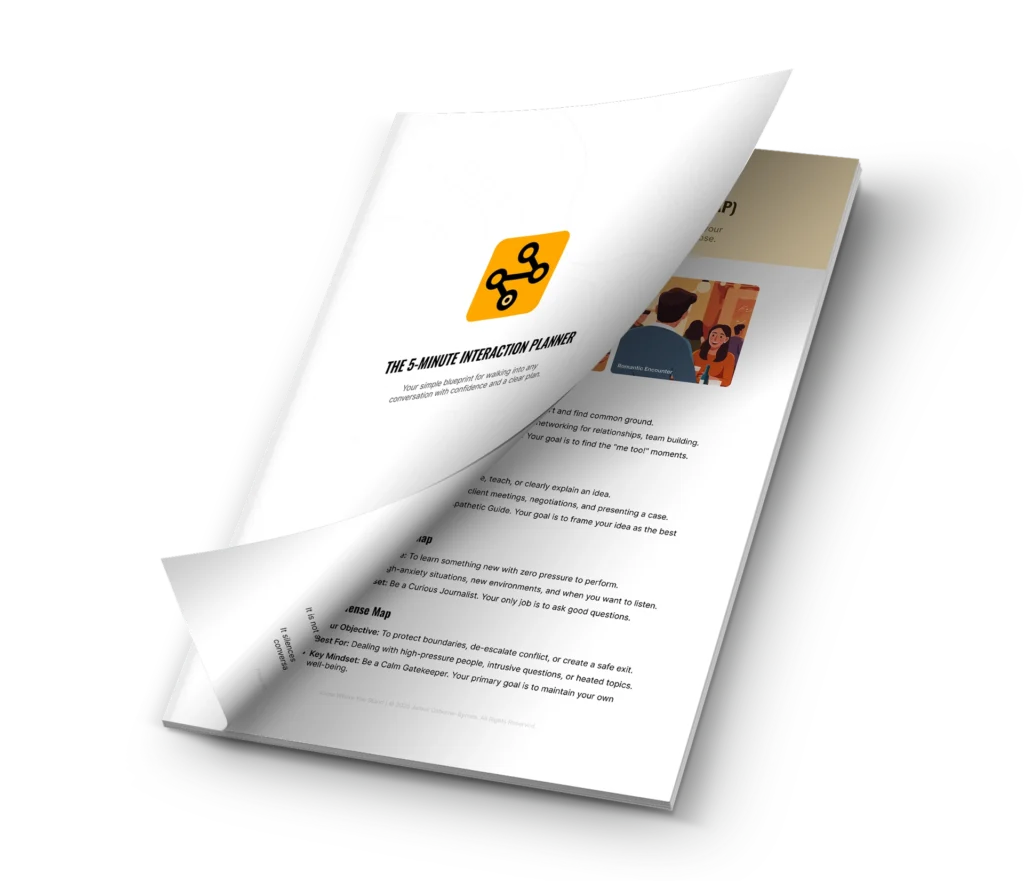It happens in a split second. Knowing how to handle awkward moments is a necessary skill when a conversation hits a wall after a one-word answer. An awkward silence hangs in the air. A voice in your head screams, “Do something!” but your mind is a blank.
This is the conversational freeze. It’s the moment your brain gets overloaded by social uncertainty and short-circuits. The good news is that learning how to handle awkward moments isn’t about memorizing clever lines. It’s about having a simple, reliable system. This playbook is that system, a three-part decision engine called The Next Move™.
The Next Move™: Your Real-Time Decision Engine for Social Friction
Think of this not as a list of tricks, but as a mental algorithm that works in three steps. It’s a process you can activate the moment you feel that conversational friction building.
Step 1: Spot the Trigger
A trigger is any conversational moment that requires a choice. It could be an awkward silence, an unexpected question, or a sudden shift in tone. This is your cue to activate the system, not to panic. The first step is recognizing the moment has arrived.
Step 2: Read the Signal Using the Traffic Light Method
You categorize the social cues you’re receiving. Instead of getting lost in a sea of nonverbal communication, you assign the moment to one of three categories. This simple act of reading social cues gives you clarity.
- Green Light (Advance): You see positive, inviting signals. The person is smiling, leaning in, or asking a follow-up question. They are adding energy to the interaction.
- Yellow Light (Clarify): You see ambiguous or neutral signals. Think polite but brief answers, a neutral expression, or a hesitant pause.
- Red Light (Pivot): You see negative or closed-off signals. The person breaks eye contact, turns their body away, or uses a dismissive tone.
Step 3: Choose a Play from the Playbook
Based on the signal you just read, you choose a corresponding action. This gives you a clear path forward.
- If Green Light → Execute an “Advance” Play: Build on the momentum. Ask a related open-ended question or share a brief, relevant personal story.
- If Yellow Light → Execute a “Clarify” Play: Gather more information without adding pressure. Make a simple observation about the environment (“It looks like a busy day”) or just hold the space in silence for a moment.
- If Red Light → Execute a “Pivot” Play: Gracefully change the subject or exit the conversation. A simple, “Well, I’ll let you get back to it. Good seeing you!” works perfectly.
Using the Playbook in Real Life
This system shows you how to fix an awkward conversation because it gives you a process instead of letting you spiral. Let’s look at a common scenario.
The Panic of the Drifter State
You ask, “Having a good time?” They reply, “Yep.” Your brain floods with self-criticism (“That was a dumb question!”) and searches frantically for what to do in the awkward silence. You blurt out something even more random, making the friction worse.
The Navigator’s Process with the System
Let’s replay that moment with the playbook.
- Trigger: The one-word answer arrives.
- Signal Read: You think, “That’s a Yellow Light. It’s not negative, but it’s not an invitation to advance.”
- Choose a Play: You calmly execute a “Clarify Play.” You make a low-pressure observation about the room. “It’s pretty loud in here, huh?” This takes the pressure off both of you and gives them an easy way to re-engage.
Become a Signal Spotter
One of the best social anxiety tips is to practice new skills in a low-stakes environment. This assignment helps you build the mental muscle for reading signals so it becomes automatic.
Your 24-Hour Assignment
- Action: While watching a TV show, movie, or listening to a podcast…
- Task: Categorize the responses you hear. When one person answers another, say to yourself, “That was a Green Light,” or “That’s a clear Yellow Light.”
- Purpose: The goal isn’t to judge or plan. You are training your brain to see conversations in this new, structured way.
The Next Move™ is your playbook for navigating conversational friction with confidence, ensuring you never freeze up again. You now have a process for how to handle awkward moments.
But great social skill isn’t just about navigating the tough moments; it’s about creating the great ones. What about those magical conversations where you just “click” with someone? That’s not an accident. It’s a phenomenon we call Map Resonance™, and in our next post, we’ll show you exactly how to engineer it.
Your Next Step
You have a tool for navigating friction. Now it’s time to learn how to use these skills to create those magical moments of genuine connection.
Continue Reading Part 8: Create Conversational Chemistry with Alignment, Not Magic →



